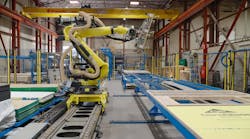In recent years, as systems, controllers, and field devices have become more advanced, the amount of data generated by building systems has grown exponentially. From lighting controls and fire/life-safety systems to access controls and parking information systems, everything in our buildings is providing more and more data.
Not long ago, if a facility manager or engineer wanted the operational details of a space or system, non-connected data-logging equipment would have to be deployed and the information gathered and read. Today, with most modern facility systems, current operating conditions and some amount of historical data are immediately available with the push of a button or a few clicks of a mouse. Every system in a modern facility has some form of data presentation; trying to keep tabs on all of the information can be overwhelming.
For example, with some systems, operators must utilize several applications to access information from all of the systems in a facility. Often, that information is very technical and system-specific and presented in a way that is difficult to understand. Because facility systems generally are not aware of other “smart” systems in the building, information has to be presented in a particular manner, as the systems are unable to correlate building-level events with specific system implications.
It is easy to see how an operator could become overwhelmed by all of these systems and find it difficult to leverage data to make better operational decisions.
To address this challenge, we need a system that can understand building operations holistically, connect disparate system information, and present data in an easily digestible manner so operators can focus on facilitating the right actions.
The solution? Integrated analytics.
By collecting data from disparate facility systems and analyzing it from a whole-building perspective, facility operators, managers, and C-suite personnel can do more with the information they already have. A good analytics package simplifies presentation by offering data from disparate systems in common domain terms. This enhances the understanding of facility operations and insights without operations staffs having to spend significant time collecting and analyzing data themselves. This improves operational efficiency and allows operators to focus on important issues.
An analytics system collects, normalizes, stores, and analyzes data for extended periods of time, potentially indefinitely. By giving vision to long-term trends from all of a facility’s connected systems, analytics provides insights into anomalies that might otherwise go unnoticed. These insights are linked to actionable opportunities that can be used by operations staffs to affect immediate change or by engineers and vendors to improve facility efficiency. By quantifying the cost of opportunities, analytics facilitates immediate discussion of impacts on systems and budgets. Also, it helps to prioritize opportunities across systems.
An integrated-analytics system can enhance operations by utilizing systems in conjunction with one another to improve efficiencies. For example, when an integrated system allows sharing of lighting-control-system occupancy-sensor data with scheduling information, opportunities for equipment-run-time reduction or dead-band expansion can be identified. Properly executed analytics identifies these opportunities as insights and quantifies the potential savings of implementing occupancy changes.
Also with integrated analytics, equipment maintenance can be prioritized. Systems an analytics package identifies as operating inefficiently can be scheduled for more frequent maintenance, while systems that are operating fine can be scheduled for maintenance less frequently.
From a project-development perspective, acquiring the data necessary to calculate baselines, identify potential measures, and determine cost and energy impacts can be quite challenging. Coordinating with a local building-automation-system (BAS) vendor to retrieve trend data and deliver it in a format that can be used for analysis sometimes can be more difficult than anticipated. When this challenge is combined with the need to set and retrieve data loggers on systems not connected to a BAS (plus the time needed to study the operation of the various systems throughout the facility), project development can become rather expensive rather quickly.
An integrated-analytics system alleviates much of the headache and cost associated with energy-project development. Because an analytics system normalizes and time-aligns stored data, historical data is easy to retrieve and often accessible from any Web browser. Most modern analytics systems allow the export of data in Excel, comma-separated, or tab-separated format, which easily imports into a multitude of engineering analysis tools.
Another advantage of having an analytics system in place when developing energy projects is the ability to leverage insights provided by the system. Cost-quantified opportunities can be used as a starting point, and data from a system can be studied to determine the scope and impact of a measure. This makes for a much faster development cycle than starting from scratch with every potential measure. Also, a system can track avoidable costs associated with potential measures, exposing the cost impact of putting off a project. This can be a powerful factor when seeking approval of energy projects.
Returning to the example of lighting occupancy sensors being used to identify potential equipment-scheduling enhancements: Not only does analytics expose such opportunities, it enables quantification of impacts and verification of performance.
Before analytics, measurement and verification (M&V) was much more difficult to perform, especially when data had to be gathered from multiple systems. With an analytics system, data from every piece of equipment in a connected system can be gathered, meaning M&V can be performed without reliance on sampling, which can result in significant deviations in verification-calculation results, if sampled data are bad. M&V can be further enhanced, with guesswork eliminated from the process, through the ability to see the impact of a project on all of the systems connected to the analytics platform. Additionally, M&V can be performed in less time, as system deficiencies are reported continuously.
By and large, as technology enables us to track more and more data, the demand for building systems that provide data to operators is increasing. The complexity of these systems and the sheer quantity of available data can overwhelm operators. Analytics is the glue that binds the data.
With an integrated-analytics system, operators can identify—and quantify the impacts of—opportunities for improvements more easily. Being able to put measurements to system recommendations enhances operators’ ability to improve system functionality, cut costs, and increase efficiencies.
SIDEBAR: Analytics in Action
Picture this: An air-handling unit is operating with a chilled-water valve that is stuck partially open. For a majority of the year, the air handler is able to maintain space comfort by adjusting fan speed and opening the hot-water valve to compensate for the stuck chilled-water valve. Because of inefficient fan operation and simultaneous heating and cooling, the air-handling system is consuming an additional $250 of energy a day. Without analytics, the operator might not be able to identify the original issue and would be unable to quantify the cost impact.
Imagine, though, that the operator catches the stuck-valve condition and gets a bid from a controls vendor to repair or replace the valve at a cost of $3,500. Normally, in such situations, minus a catastrophic failure of a system component, bids are collected and budgeted for during the next budget cycle, which often can be several months away. Each day our facility operates, the air handler is wasting potentially hundreds of dollars in energy without having any significant operational impact, and the repair continues to be put off until the time for which it was budgeted. By the time the valve is repaired, tens of thousands of dollars in energy, which is orders of magnitude greater than the cost of replacing the valve, has been wasted.
Todd Knapek is a manager of technology solutions for Envise, a building-systems integrator uniting building automation, mechanical service, and analytics. He can be reached at [email protected].
Did you find this article useful? Send comments and suggestions to Executive Editor Scott Arnold at [email protected].










